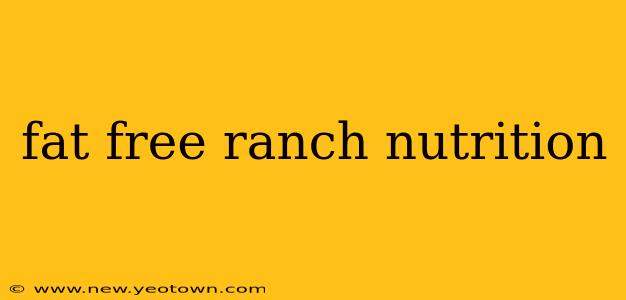Ah, ranch dressing. That creamy, tangy dip that elevates everything from salads to veggies to chicken wings. But what about the nutritional profile, especially when we're talking fat-free versions? Let's dive into the world of fat-free ranch dressing, exploring its nutritional content, potential benefits, and drawbacks. This isn't just about numbers; it's about understanding how this popular condiment fits into a balanced diet.
What are the Calories in Fat-Free Ranch?
The calorie count in fat-free ranch dressing can vary slightly depending on the brand, but generally, you're looking at around 15-30 calories per tablespoon. This is significantly lower than its full-fat counterpart, which can pack in 60-100 calories or more per tablespoon. The reduction in calories primarily comes from the removal of fat.
Is Fat-Free Ranch Dressing Healthy?
This is where things get a little more nuanced. While the low calorie count is attractive, the health benefits of fat-free ranch are less straightforward. The removal of fat often leads to an increase in other ingredients to maintain flavor and texture. This can mean a higher sodium content and a greater reliance on added sugars and thickeners. So, while it's lower in calories and fat, it might not necessarily be a "healthier" choice overall.
What are the Ingredients in Fat-Free Ranch Dressing?
This is crucial information because it greatly influences the nutritional value. Common ingredients include water, buttermilk, vinegar, herbs (like parsley and dill), spices, and thickeners. However, pay close attention to the ingredient list for added sugars, artificial sweeteners, and high levels of sodium. Some brands focus on more natural ingredients, while others prioritize cost-effectiveness, resulting in less desirable additions.
How Much Sodium is in Fat-Free Ranch?
Sodium is a major concern with many fat-free dressings. Because fat contributes to flavor, removing it often necessitates adding more sodium to compensate. A single tablespoon of fat-free ranch can contain a significant portion of your daily recommended sodium intake. Always check the nutrition label to be aware of the sodium content.
Does Fat-Free Ranch Have Sugar?
While some brands aim for minimal added sugars, many fat-free ranch dressings contain added sugars or artificial sweeteners to enhance taste and texture. These added sugars can contribute to unwanted calorie intake and other health concerns.
Is Fat-Free Ranch Better Than Regular Ranch?
Ultimately, there's no definitive "better" choice between fat-free and regular ranch. It depends entirely on your individual dietary needs and preferences. If calorie restriction is your primary goal, fat-free ranch may be the better option. However, if you're concerned about sodium and added sugars, you may want to consider regular ranch in moderation or explore homemade alternatives with healthier fats and natural sweeteners.
Can I Make My Own Fat-Free Ranch Dressing?
Absolutely! Making your own fat-free ranch gives you complete control over the ingredients. You can easily adjust the levels of herbs, spices, and sodium to meet your preferences and dietary needs. Numerous recipes are readily available online, offering various flavor profiles and ingredient options.
By understanding the nutritional composition and potential trade-offs involved, you can make an informed choice about incorporating fat-free ranch into your diet. Remember that moderation and mindful consumption are key to a balanced and healthy eating plan.

